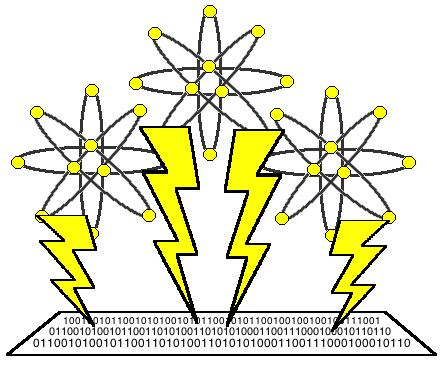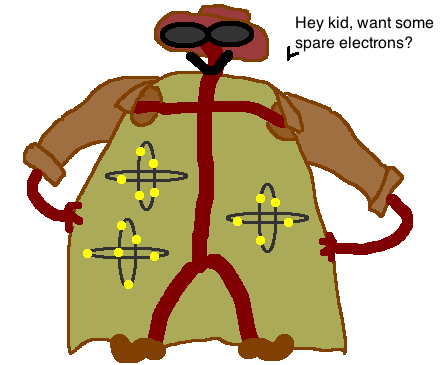Begun the digital revolution has.
ENIAC was a series of 20,000 vacuum tubes, 7,200 diodes, 1,500 electrical relays, 70,000 resistors, and 10,000 capacitors that turned a bunch of on/off switches into a series of holes in a card that could then be converted into a number or other values based on how the holes were punched.

Pray tell, what then is the difference between this "analog" and "digital" thing?
First you just GOTSTA GOTSTA GOTSTA KNOW what a digital even is, kk .. kk!
We've already talked about amps, volts and watts, and mentioned some stuff that can hold electricity and do things with it, like the capacitor, resistor, diode and other nefarious creatures of the electrical night. BUT we ain't gone into how that stuff actually works, ya hear!
AND WE'RE NOT! We're not trying to learn Electrical Engineering here, we're trying to learn Software Engineering .. right!???
THERE CAN NOT BE SOFTWARE WITHOUT ELECTRICITY!
So yes, you're going to get the low down on what it takes to be a wizard of the digital world, but first, we've got to cram a bunch of words in your head, so when you start learning about registers and static, you won't think we're going to the grocery store to watch the snow on the TV.

In case you didn't know, you can't just put a bunch of resistors, capacitors and diodes in a series and expect them to do stuff with 1's and 0's. You need to know the math, thermo dynamics, and a slew of other nomenclature before you can even start tying those parts together with wire and solder.
That configuration and way you tie the parts together is called an electronic circuit, or electrical circuit if you don't put something in the circuit that can be active, like a vacuum tube or diode. That circuit then takes the electrical current flowing through it, and then does something with it, so it's taking an electrical "signal" (the electrons pumping through the circuit) and turning it into "work" (physics work, not job-get-paid work .. but you can get paid doing physics work!). Kinda like how a light bulb turns the electrical signal from the light socket into heat energy, which we see as light, due to the metal resistor in the vacuum tube.
Unfortunately not all electrical devices are created equal ...
Just because you shove 5 volts down a wire does not mean that you'll get the full 5 on the other end. You might get 4.95 volts because the wire wanted to be greedy and hold on to a few electrons. Or you might even get 6 volts because the wire was feeling extremely generous!

Ultimately there lies the basic difference between analog and digital.
A digital system is one that takes the electrical circuit, and turns the signal into something that can then be treated as a set of numbers (a.k.a. digits). It does this by eliminating electrical noise and clamping down the electrical values into certain ranges that then get treated as numbers.
On the other hand, an analog system is one that treats the electrical values of the circuit directly as they are, in other words, it works directly with the amps and volts as they are.
For example, we could shove 5 volts (also written 5V) through our electronic circuit and treat all values in the range of 1.5V - 2V as a 1, 2.5V - 3V as a 2, 3.5V - 4V as a 3, and 4.5V - 5V as a 4. That circuit is considered a "digital" circuit because we are treating the ranges as digits.
If we instead had certain electrical paths "open" up at 1.5V and then "close" off when it reaches 2V, only to "open" again at 2.5V and "close" at 3V, and so forth and so on ... that is an analog system.
The crazy thing ... ANYTHING you can do with a digital system, you CAN do with an analog system, and totally the other way too!
In other words, anything that can be done by a computer with software, can be built as an analog system with a bunch of gears, switches, wires, capacitors, diodes, resistors, and more!

Granted, the thing would likely be the size of a room and that would probably only account for a few pieces of what a modern CPU/RAM combo does .... OH WAIT! That's exactly how it was with ENIAC!
ENIAC used those series of electronic circuits to create one of the first general purpose, reprogrammable processors. It used the vacuum tubes to read the pulses of electricity, much like a gear turning to keep count. It kept count by flipping some diodes on or off based on the circuit pathways and electrical signal, and then charging up the capacitors to hold that value for later use.
Today, we call that a CPU register and RAM; but that's getting ahead of ourselves.
ENIAC also dealt with the electrical voltage ranges and treated the ranges as either a 1 or a 0, in turn making it a binary system. Bin is a latin root meaning 2, and ary is a latin suffix that means "pertaining to". Don't worry about how we turn binary into other things, we'll cover that later, we promise!
From here, we did what we could to make capacitors, resistors and diodes ever smaller. In that hayday, we ended up creating another amazing electrical device that was instrumental in modern computing: the transistor!
With the advent of the transistor, we could start making more discrete and integrated circuits that didn't get so buzzing hot, as well as finally have debates over silicon versus silicone !

We wanted to go to another state, and it was solid!
ENIAC was a series of 20,000 vacuum tubes, 7,200 diodes, 1,500 electrical relays, 70,000 resistors, and 10,000 capacitors that turned a bunch of on/off switches into a series of holes in a card that could then be converted into a number or other values based on how the holes were punched.

Pray tell, what then is the difference between this "analog" and "digital" thing?
First you just GOTSTA GOTSTA GOTSTA KNOW what a digital even is, kk .. kk!
We've already talked about amps, volts and watts, and mentioned some stuff that can hold electricity and do things with it, like the capacitor, resistor, diode and other nefarious creatures of the electrical night. BUT we ain't gone into how that stuff actually works, ya hear!
AND WE'RE NOT! We're not trying to learn Electrical Engineering here, we're trying to learn Software Engineering .. right!???
THERE CAN NOT BE SOFTWARE WITHOUT ELECTRICITY!
So yes, you're going to get the low down on what it takes to be a wizard of the digital world, but first, we've got to cram a bunch of words in your head, so when you start learning about registers and static, you won't think we're going to the grocery store to watch the snow on the TV.

In case you didn't know, you can't just put a bunch of resistors, capacitors and diodes in a series and expect them to do stuff with 1's and 0's. You need to know the math, thermo dynamics, and a slew of other nomenclature before you can even start tying those parts together with wire and solder.
That configuration and way you tie the parts together is called an electronic circuit, or electrical circuit if you don't put something in the circuit that can be active, like a vacuum tube or diode. That circuit then takes the electrical current flowing through it, and then does something with it, so it's taking an electrical "signal" (the electrons pumping through the circuit) and turning it into "work" (physics work, not job-get-paid work .. but you can get paid doing physics work!). Kinda like how a light bulb turns the electrical signal from the light socket into heat energy, which we see as light, due to the metal resistor in the vacuum tube.
Unfortunately not all electrical devices are created equal ...
Just because you shove 5 volts down a wire does not mean that you'll get the full 5 on the other end. You might get 4.95 volts because the wire wanted to be greedy and hold on to a few electrons. Or you might even get 6 volts because the wire was feeling extremely generous!

Ultimately there lies the basic difference between analog and digital.
A digital system is one that takes the electrical circuit, and turns the signal into something that can then be treated as a set of numbers (a.k.a. digits). It does this by eliminating electrical noise and clamping down the electrical values into certain ranges that then get treated as numbers.
On the other hand, an analog system is one that treats the electrical values of the circuit directly as they are, in other words, it works directly with the amps and volts as they are.
For example, we could shove 5 volts (also written 5V) through our electronic circuit and treat all values in the range of 1.5V - 2V as a 1, 2.5V - 3V as a 2, 3.5V - 4V as a 3, and 4.5V - 5V as a 4. That circuit is considered a "digital" circuit because we are treating the ranges as digits.
If we instead had certain electrical paths "open" up at 1.5V and then "close" off when it reaches 2V, only to "open" again at 2.5V and "close" at 3V, and so forth and so on ... that is an analog system.
The crazy thing ... ANYTHING you can do with a digital system, you CAN do with an analog system, and totally the other way too!
In other words, anything that can be done by a computer with software, can be built as an analog system with a bunch of gears, switches, wires, capacitors, diodes, resistors, and more!

Granted, the thing would likely be the size of a room and that would probably only account for a few pieces of what a modern CPU/RAM combo does .... OH WAIT! That's exactly how it was with ENIAC!
ENIAC used those series of electronic circuits to create one of the first general purpose, reprogrammable processors. It used the vacuum tubes to read the pulses of electricity, much like a gear turning to keep count. It kept count by flipping some diodes on or off based on the circuit pathways and electrical signal, and then charging up the capacitors to hold that value for later use.
Today, we call that a CPU register and RAM; but that's getting ahead of ourselves.
ENIAC also dealt with the electrical voltage ranges and treated the ranges as either a 1 or a 0, in turn making it a binary system. Bin is a latin root meaning 2, and ary is a latin suffix that means "pertaining to". Don't worry about how we turn binary into other things, we'll cover that later, we promise!
From here, we did what we could to make capacitors, resistors and diodes ever smaller. In that hayday, we ended up creating another amazing electrical device that was instrumental in modern computing: the transistor!
With the advent of the transistor, we could start making more discrete and integrated circuits that didn't get so buzzing hot, as well as finally have debates over silicon versus silicone !

We wanted to go to another state, and it was solid!